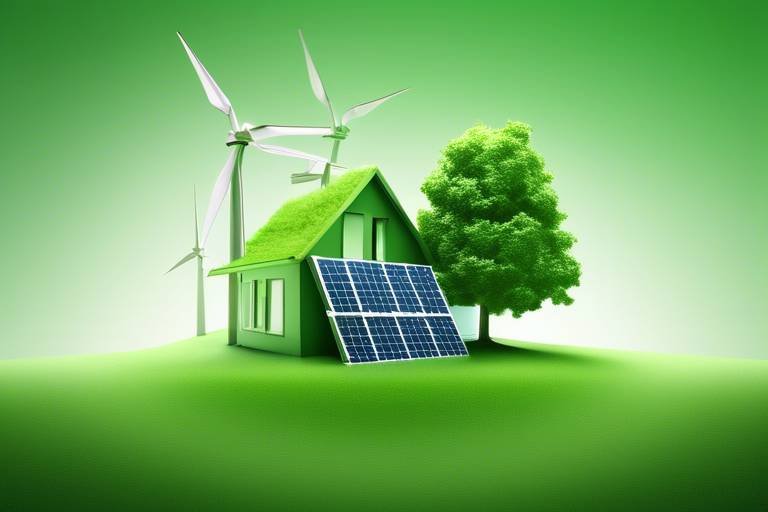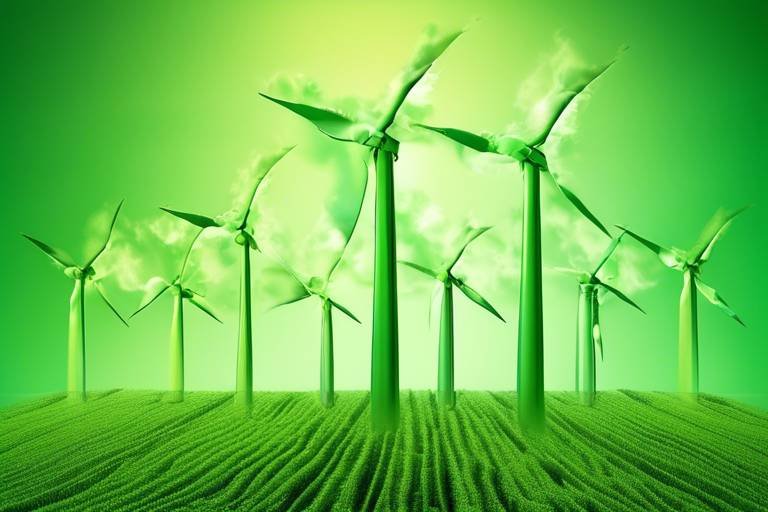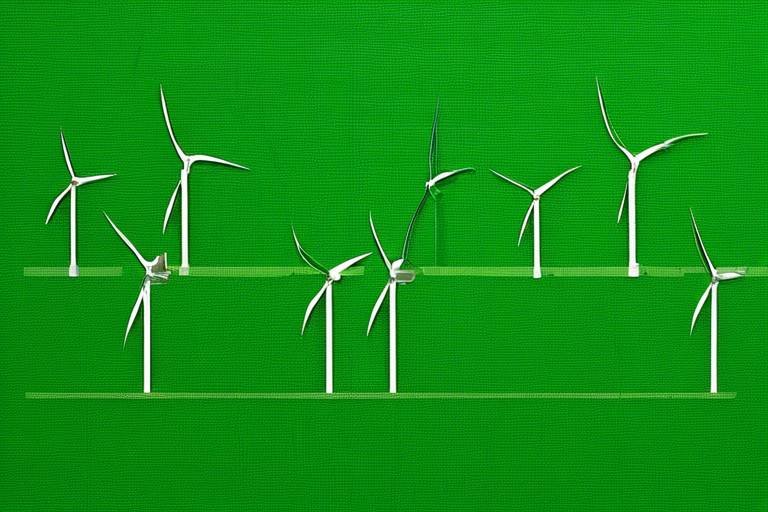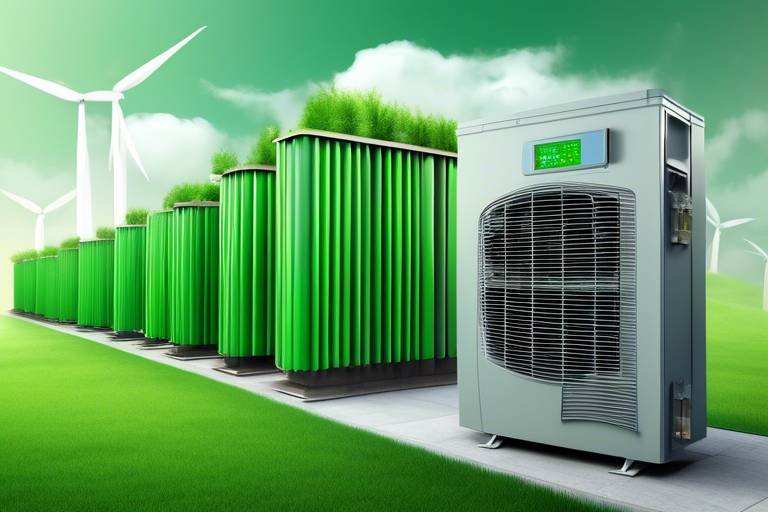Decoding the Impact of Green Energy on Economy
The world is at a pivotal crossroads, where the transition to green energy is not just a trend but a necessity. As we strive for a sustainable future, understanding how this shift impacts our economy is crucial. Green energy encompasses renewable sources like solar, wind, and hydroelectric power, and its influence stretches far beyond just environmental benefits. It plays a significant role in economic growth, job creation, and even reshaping our communities. In this article, we will delve into the multifaceted impact of green energy on the economy, exploring both the challenges and opportunities that arise from this transition.
Renewable energy sources are crucial for driving economic growth. The infusion of investments in solar, wind, and hydroelectric power contributes significantly to the Gross Domestic Product (GDP) and overall economic stability. Imagine a bustling city powered by clean energy, where businesses thrive without the burden of fluctuating fossil fuel prices. This is not just a dream; it’s a reality that many regions are beginning to embrace. The renewable energy sector has shown a remarkable capacity to stimulate local economies, creating not only jobs but also fostering innovation and attracting new businesses.
For instance, when a community invests in solar farms, it doesn't just enhance energy independence; it also brings in revenue through job creation and local spending. The ripple effect is profound, as these investments lead to increased demand for local services, from construction to maintenance, ultimately boosting the economy. Moreover, the shift towards renewable energy can help mitigate the risks associated with climate change, which can have severe economic repercussions if left unchecked.
The transition to green energy has led to significant job creation. As traditional energy sectors face decline, the renewable energy sector is booming, offering a plethora of new job opportunities. From engineers designing cutting-edge solar panels to technicians installing wind turbines, the variety of roles is as diverse as the energy sources themselves. The skills required to thrive in this evolving industry are equally varied, ranging from technical expertise to project management and regulatory compliance.
As the green energy sector expands, new career opportunities arise. Some of the most promising job roles include:
- Solar Photovoltaic Installers: These professionals are responsible for setting up solar panel systems on rooftops and other structures.
- Wind Turbine Technicians: They maintain and repair wind turbines, ensuring optimal performance and safety.
- Energy Efficiency Auditors: These experts assess buildings and systems to recommend improvements that reduce energy consumption.
These roles not only provide employment but also contribute to local economies by increasing spending power and fostering innovation. The demand for skilled workers in the renewable sector is expected to grow, making it an attractive field for job seekers.
To meet the demand for skilled workers, educational programs are adapting. Many universities and vocational schools are now offering specialized programs focused on renewable energy technologies. These initiatives are crucial in equipping individuals with the necessary skills to excel in green jobs. Training programs often include hands-on experience, which is vital for understanding the complexities of renewable energy systems. In addition, partnerships between educational institutions and industry leaders are emerging, creating pathways for students to gain real-world experience and job placements.
Automation is reshaping the job landscape within the green energy sector. While technology can enhance efficiency and reduce costs, it also raises questions about job availability. For instance, while solar panel installation may be increasingly automated, the need for skilled technicians to oversee these systems remains. Understanding how to balance automation with job creation is critical for ensuring a sustainable workforce in the renewable energy sector.
Despite its benefits, transitioning to green energy poses economic challenges. The initial investment costs can be daunting for businesses and governments alike. Market fluctuations can also impact the stability of renewable energy projects, creating uncertainty for investors. Additionally, there may be resistance from traditional energy sectors, which can hinder progress. Addressing these financial hurdles and market dynamics is essential for a smooth transition to a green economy.
Government initiatives play a vital role in promoting green energy. Policies and incentives not only encourage investment but also stimulate innovation within the renewable energy sector. Governments worldwide are recognizing the importance of supporting sustainable energy sources, leading to a surge in initiatives aimed at fostering growth.
Tax incentives and subsidies are critical for fostering green energy growth. Various financial benefits are available to businesses and consumers investing in renewable technologies. These incentives can significantly lower the cost of solar panels, wind turbines, and other renewable energy installations, making them more accessible to a broader audience. Such support is crucial for accelerating the adoption of green technologies and ensuring a competitive market.
Effective regulatory frameworks are essential for the success of green energy initiatives. Laws and regulations governing renewable energy production and distribution must be clear and supportive. This includes streamlining the permitting process for new projects, ensuring fair competition, and providing guidelines for sustainable practices. A robust regulatory environment can foster innovation and attract investment, ultimately benefiting the economy and the environment.
Q1: What are the main benefits of green energy for the economy?
A1: Green energy promotes economic growth by creating jobs, enhancing energy independence, and stimulating local economies through investment in renewable technologies.
Q2: How does the transition to green energy impact job availability?
A2: While some traditional jobs may decline, the green energy sector is rapidly expanding, creating new opportunities that require a diverse set of skills.
Q3: What role do government policies play in supporting green energy?
A3: Government policies, including tax incentives and regulatory frameworks, are crucial in promoting investment and innovation in the renewable energy sector.

The Role of Renewable Energy in Economic Growth
Renewable energy sources are not just a trend; they are the backbone of a sustainable economic future. As countries around the globe pivot away from fossil fuels, the economic growth associated with renewable energy is becoming increasingly evident. Investments in solar, wind, and hydroelectric power are not merely environmentally friendly choices; they are also powerful engines driving up GDP and enhancing overall economic stability.
Consider this: when a government invests in renewable energy projects, it’s not just about creating a cleaner environment; it’s about revitalizing the economy. For instance, the construction and maintenance of solar farms and wind turbines require a significant workforce. This surge in job creation not only lowers unemployment rates but also stimulates local economies through increased spending. As more people find jobs in the green energy sector, they contribute to their communities, creating a ripple effect that benefits everyone.
Moreover, the renewable energy sector is characterized by its diversity of opportunities. From manufacturing solar panels to installing wind turbines, the range of jobs available is vast. This diversity is essential for economic resilience, as it reduces reliance on any single industry. For example, during economic downturns, traditional energy sectors may struggle, but renewable energy has shown a remarkable ability to remain stable and grow, providing a buffer against economic shocks.
To illustrate the impact of renewable energy investments on economic growth, let’s take a look at the following table:
| Type of Renewable Energy | Investment Impact on GDP (%) | Job Creation Potential |
|---|---|---|
| Solar Energy | 1.5% | 5 jobs per MW installed |
| Wind Energy | 1.2% | 6 jobs per MW installed |
| Hydroelectric Energy | 0.8% | 4 jobs per MW installed |
This table highlights how different types of renewable energy not only contribute to GDP but also create jobs at varying rates. The potential for job creation in the renewable sector is staggering, especially when you consider the ongoing demand for clean energy solutions. As more countries commit to reducing their carbon footprints, the need for skilled labor in this field will only increase.
In summary, the role of renewable energy in economic growth is multifaceted. It promotes job creation, stimulates local economies, and enhances national GDP. The transition to renewable energy is not just an environmental imperative; it is an economic opportunity that countries cannot afford to overlook. As we continue to embrace these sustainable practices, we pave the way for a brighter, more prosperous future.
- What are the main benefits of renewable energy for the economy? Renewable energy contributes to job creation, stimulates local economies, and enhances GDP.
- How does renewable energy impact job creation? The renewable energy sector creates a diverse range of jobs, from manufacturing to installation and maintenance.
- Are there financial incentives for investing in renewable energy? Yes, many governments offer tax incentives and subsidies to encourage investment in renewable technologies.
- What types of renewable energy are most impactful for economic growth? Solar, wind, and hydroelectric energy are among the most impactful in terms of GDP contribution and job creation.

Job Creation in the Green Energy Sector
The transition to green energy isn’t just an environmental imperative; it’s also a tremendous opportunity for job creation. As the world shifts away from fossil fuels and embraces renewable sources like solar, wind, and hydroelectric power, the demand for a skilled workforce is skyrocketing. This shift is akin to the industrial revolution, where new technologies and industries emerged, paving the way for countless job opportunities. But what exactly does this mean for the workforce?
In the green energy sector, a diverse array of roles is emerging, each playing a pivotal part in the renewable energy landscape. From engineers and technicians to project managers and sales representatives, the job market is expanding rapidly. For instance, according to recent studies, the solar industry alone has created over 250,000 jobs in the United States, and this number continues to grow as more households and businesses invest in solar technology.
As we delve deeper into the types of jobs being created, it’s essential to recognize that this sector isn’t just about traditional roles. The green energy industry is fostering entirely new career paths that didn’t exist a decade ago. Here are some prominent job categories:
- Solar Photovoltaic Installers: These professionals are responsible for installing solar panels on rooftops and other structures. The job requires technical skills and knowledge of electrical systems.
- Wind Turbine Technicians: With the rise of wind farms, technicians are needed to maintain and repair wind turbines, ensuring they operate efficiently.
- Energy Auditors: These specialists assess energy usage in buildings and recommend improvements to enhance efficiency and reduce costs.
Moreover, the green energy sector is not just about the jobs it creates but also the skills required to thrive in this evolving industry. Employers are seeking individuals who are not only technically proficient but also adaptable and innovative. This demand is pushing educational institutions to revamp their curricula to include specialized training programs focused on renewable energy technologies.
As we look towards the future, it's evident that the green energy sector is a beacon of job creation. However, this transition also necessitates a workforce that is equipped with the right skills. Educational institutions and training programs are stepping up to meet this need, ensuring that workers are prepared to take on these exciting new roles.
In conclusion, the green energy sector is not just reshaping our environment; it’s also transforming our economy by creating a wealth of job opportunities. As we continue to invest in renewable technologies, the potential for job growth is immense, paving the way for a sustainable future for both the planet and the workforce.
- What types of jobs are available in the green energy sector? The sector offers a variety of roles, including solar installers, wind turbine technicians, energy auditors, and project managers.
- How can I prepare for a job in renewable energy? Acquiring technical skills through training programs and educational courses focused on renewable technologies is essential.
- Is there a demand for green energy jobs? Yes, the demand for skilled workers in the green energy sector is rapidly increasing as more investments are made in renewable technologies.

Emerging Careers in Renewable Energy
As the green energy sector continues to expand, it brings with it a wave of exciting career opportunities that not only promise personal growth but also contribute significantly to the economy. Imagine a world where your job not only pays the bills but also helps save the planet! This is the reality for many individuals entering the renewable energy field. From solar panel technicians to wind energy engineers, the landscape is rich with roles that cater to a variety of skills and interests.
One of the most intriguing aspects of this shift is the diversity of roles emerging within the sector. For instance, solar energy specialists are in high demand as more homeowners and businesses turn to solar solutions to reduce their carbon footprint. These professionals are responsible for designing, installing, and maintaining solar power systems, making them essential players in the renewable energy game.
Similarly, wind turbine technicians are becoming increasingly vital as wind farms proliferate across the globe. These technicians not only install and maintain wind turbines but also ensure they operate at peak efficiency. With the wind industry expected to grow exponentially, this career path is not just promising; it's essential for a sustainable future.
Moreover, the rise of energy efficiency consultants reflects a growing awareness of the need to optimize energy use in homes and businesses. These consultants analyze energy consumption patterns and recommend strategies to reduce waste, ultimately saving money and conserving resources. This role is perfect for those who enjoy problem-solving and have a knack for data analysis.
To give you a clearer picture of the emerging roles in renewable energy, here’s a quick overview:
| Job Title | Key Responsibilities | Skills Required |
|---|---|---|
| Solar Energy Specialist | Design, install, and maintain solar power systems | Technical knowledge, problem-solving, customer service |
| Wind Turbine Technician | Install and maintain wind turbines | Mechanical skills, safety knowledge, troubleshooting |
| Energy Efficiency Consultant | Analyze energy use and recommend savings strategies | Analytical skills, communication, project management |
As these careers evolve, so does the need for training and education tailored specifically for the green energy sector. Educational institutions are recognizing this demand and are adapting their programs accordingly. Whether it’s through vocational training, online courses, or degree programs, there are numerous avenues for individuals looking to break into this field. The blend of practical skills and theoretical knowledge is essential for anyone aiming to thrive in these emerging roles.
In conclusion, the transition to renewable energy is not just an environmental necessity; it’s a catalyst for a new wave of job creation. The emerging careers in this sector are not only diverse and fulfilling, but they also play a crucial role in shaping a sustainable future. So, if you’re considering a career change or just starting out, the green energy field may be your golden ticket to making a difference while enjoying a rewarding professional life!
- What types of jobs are available in the renewable energy sector? There are various roles including solar energy specialists, wind turbine technicians, and energy efficiency consultants.
- Do I need a degree to work in renewable energy? While some positions require specific degrees, many roles also offer vocational training and certifications.
- What skills are important for a career in green energy? Key skills include technical knowledge, analytical abilities, problem-solving, and effective communication.
- Is the renewable energy industry growing? Yes, the renewable energy sector is expanding rapidly, leading to increased job opportunities and economic growth.

Training and Education for Green Jobs
The transition to a greener economy is not just about installing solar panels or wind turbines; it requires a well-trained workforce equipped with the right skills. As the demand for renewable energy sources surges, so does the need for specialized training programs that prepare individuals for a variety of roles in this burgeoning industry. Educational institutions, from community colleges to universities, are rapidly adapting their curricula to meet these needs, ensuring that students are not only aware of the environmental impacts of energy production but also possess the technical expertise necessary to thrive in this evolving job market.
One of the most significant aspects of training for green jobs is the emphasis on hands-on experience. Many programs are incorporating internships and apprenticeships that allow students to gain real-world experience while they learn. This practical approach not only enhances their understanding of renewable technologies but also makes them more attractive to potential employers. For instance, students might engage in projects that involve the installation of solar panels or the maintenance of wind turbines, giving them a leg up in the job market.
Moreover, the skill sets required in the green energy sector are diverse and often interdisciplinary. A range of fields including engineering, environmental science, and even business management play crucial roles in the development and implementation of renewable energy projects. For example, engineers are essential for designing efficient systems, while environmental scientists help assess the ecological impact of new technologies. To highlight the variety of skills needed, consider the following table:
| Job Role | Required Skills |
|---|---|
| Renewable Energy Engineer | Engineering principles, project management, technical design |
| Solar Panel Installer | Electrical knowledge, troubleshooting, physical stamina |
| Environmental Consultant | Analytical skills, regulatory knowledge, communication |
| Energy Auditor | Assessment techniques, data analysis, reporting |
In addition to technical skills, soft skills are equally important in the green energy sector. Communication, teamwork, and problem-solving abilities are essential, as many projects require collaboration among diverse teams of professionals. Educational programs are increasingly focusing on these skills through workshops and group projects, preparing students to navigate the complexities of the renewable energy landscape effectively.
To further support this transition, various organizations and government initiatives are providing resources and funding for training programs. Grants and scholarships aimed at students pursuing careers in renewable energy are becoming more prevalent, making education in this field more accessible. Community outreach programs are also playing a vital role, especially in underrepresented communities, by offering training sessions that focus on local renewable energy projects.
As we look to the future, the importance of training and education in green jobs cannot be overstated. With the right support and resources, we can cultivate a workforce that is not only skilled but also passionate about creating a sustainable future. The impact of these educational initiatives will resonate throughout local economies, driving innovation and providing opportunities for everyone involved.
- What types of training programs are available for green jobs? There are various programs, including vocational training, online courses, and degree programs focused on renewable energy technologies.
- How can I find internships in the green energy sector? Many educational institutions have partnerships with local companies, and job boards often list internships in renewable energy.
- Are green jobs well-paying? Yes, many roles in the green energy sector offer competitive salaries, especially as demand for skilled workers continues to grow.
- What skills are most in demand in the green energy industry? Technical skills in engineering and installation, as well as soft skills like communication and teamwork, are highly sought after.

Impact of Automation on Green Jobs
The integration of automation into the green energy sector is a double-edged sword, presenting both opportunities and challenges. On one hand, automation can significantly enhance efficiency and reduce operational costs, allowing companies to produce renewable energy at a lower price. For instance, automated systems can optimize the performance of solar panels or wind turbines, ensuring they operate at peak efficiency with minimal human intervention. However, this technological advancement also raises concerns about job displacement. As machines take over routine tasks, the demand for certain types of labor may decline, leading to a shift in the job market.
Consider the role of robotics in solar panel installation. While these machines can install panels faster and more accurately than humans, they also mean fewer jobs for installers. This shift prompts the question: how can workers adapt to remain relevant in an increasingly automated landscape? The answer lies in upskilling and reskilling. Workers will need to acquire new skills that complement automation rather than compete with it. For example, technicians who can maintain and repair automated systems will be in high demand, as will data analysts who can interpret the vast amounts of data generated by automated processes.
Moreover, the impact of automation is not uniform across the green energy sector. Different renewable energy sources will experience varying levels of automation. In the wind energy sector, for instance, predictive maintenance powered by AI can prevent costly downtimes, enhancing job security for those in maintenance roles. Conversely, in areas like hydroelectric power, the reliance on automation may lead to a more significant reduction in manual labor positions.
To illustrate the impact of automation on job roles in the green energy sector, consider the following table:
| Job Role | Impact of Automation | Future Outlook |
|---|---|---|
| Solar Panel Installer | Reduced demand due to automated installation | Shift towards maintenance and system optimization roles |
| Wind Turbine Technician | Increased efficiency through predictive maintenance | Stable demand with a focus on advanced technical skills |
| Energy Data Analyst | Higher demand for data interpretation skills | Growth in job opportunities as data becomes central to operations |
In conclusion, while automation in the green energy sector poses challenges, it also paves the way for new job opportunities that require advanced skills. The key for workers is to embrace lifelong learning and adaptability. As the landscape of green jobs evolves, those who are willing to evolve with it will find themselves at the forefront of this exciting industry.
- Will automation eliminate all green jobs? No, while automation may reduce some roles, it will also create new opportunities that require different skill sets.
- How can workers prepare for the changes brought by automation? Workers can prepare by investing in education and training programs that focus on advanced technical skills relevant to the green energy sector.
- Are there specific industries within green energy that will be more affected by automation? Yes, industries such as solar energy installation may see a greater impact, while roles in maintenance and data analysis may see growth.

Economic Challenges of Transitioning to Green Energy
The transition to green energy, while essential for a sustainable future, is not without its economic challenges. As we pivot from fossil fuels to renewable sources, we encounter a landscape filled with both hurdles and opportunities. One of the most significant challenges is the initial investment cost. Setting up solar panels, wind turbines, and other renewable energy infrastructures can require substantial capital. This upfront expenditure can deter businesses and governments from making the switch, especially when existing fossil fuel systems are already in place and operational. Think of it like renovating your home; while the long-term benefits of energy efficiency are clear, the initial costs can be daunting.
Moreover, the market fluctuations associated with renewable energy sources can create uncertainty. Prices for solar panels and wind turbines, for example, can be volatile, influenced by global supply chains and technological advancements. This unpredictability can make it challenging for investors to commit to long-term projects. A sudden drop in prices can also lead to a situation where previously viable projects become economically unfeasible, causing a ripple effect through the economy.
Another critical aspect to consider is the job displacement that can occur during this transition. While new jobs are being created in the green energy sector, there is often a gap between the skills required for these new roles and those possessed by workers in traditional energy sectors. This mismatch can lead to unemployment or underemployment, creating social and economic strain. For instance, a coal miner may not have the necessary skills to work in a solar farm, and without adequate retraining programs, these individuals may find themselves struggling to adapt.
To further complicate matters, the infrastructure needed to support renewable energy is still developing in many regions. Existing power grids may not be equipped to handle the influx of energy from renewable sources, necessitating upgrades and expansions. This can lead to additional costs and delays in implementation. In some cases, the geographic distribution of renewable resources, such as wind or sunlight, may not align with population centers, complicating energy distribution logistics.
Lastly, there are political and regulatory challenges that can impede progress. The energy sector is heavily influenced by government policies, and shifts in political leadership can result in abrupt changes to regulations and incentives. For example, a new administration may choose to reduce subsidies for renewable projects, making them less attractive to investors. This uncertainty can stifle innovation and slow down the transition to a greener economy.
In summary, while the transition to green energy is crucial for sustainable development, it is essential to navigate the economic challenges that accompany it. Addressing these issues requires a coordinated effort from governments, businesses, and educational institutions to ensure that the shift is not only environmentally beneficial but also economically viable.
- What are the main economic challenges of transitioning to green energy? The main challenges include high initial investment costs, market fluctuations, job displacement, infrastructure limitations, and political uncertainties.
- How can job displacement be addressed during the transition? By implementing retraining programs and educational initiatives to equip workers with the necessary skills for new roles in the green energy sector.
- Why is infrastructure important for renewable energy? Adequate infrastructure is necessary to support the distribution and integration of renewable energy sources into the existing power grid.
- What role do government policies play in green energy? Government policies can provide incentives and regulations that encourage investment and innovation in renewable energy, impacting its growth and development.

Government Policies Supporting Green Energy
The transition to green energy is not just a trend; it's a necessity for a sustainable future. Government policies play a pivotal role in this transformation, acting as catalysts for change. By implementing supportive measures, governments can stimulate investment in renewable energy technologies, encouraging both businesses and consumers to make the switch. These policies can manifest in various forms, from financial incentives to regulatory frameworks, all designed to create a favorable environment for green energy development.
One of the most significant ways that governments support green energy is through subsidies and tax incentives. These financial benefits lower the cost barrier for both consumers and businesses looking to invest in renewable technologies. For instance, when a household installs solar panels, they might receive tax credits that significantly reduce the overall cost. Similarly, businesses may benefit from grants or subsidies that help offset the initial investment in wind turbines or bioenergy systems. This financial support not only makes renewable energy more accessible but also encourages innovation in the sector.
In addition to financial incentives, regulatory frameworks are essential for the success of green energy initiatives. Governments establish laws and regulations that dictate how renewable energy is produced and distributed. These frameworks ensure that energy providers adhere to environmental standards while promoting fair competition in the market. For example, many countries have set renewable energy targets, requiring a certain percentage of energy to come from renewable sources by specific deadlines. Such regulations not only drive the growth of the green energy sector but also help mitigate climate change.
| Policy Type | Description | Impact |
|---|---|---|
| Subsidies | Financial support for renewable energy projects. | Lower costs for consumers and businesses, increased adoption of green technologies. |
| Tax Incentives | Tax credits and deductions for renewable energy investments. | Encourages investment in solar, wind, and other renewable sources. |
| Regulatory Frameworks | Legislation that governs renewable energy production and distribution. | Ensures compliance with environmental standards and promotes market stability. |
Moreover, the impact of government policies extends beyond just financial aspects. They also foster a culture of innovation and research. By funding research and development initiatives, governments can help advance new technologies that make renewable energy more efficient and cost-effective. This investment in innovation not only benefits the environment but also positions countries as leaders in the global green energy market.
However, it's essential to recognize that the effectiveness of these policies can vary. In some cases, political will and public support can wane, leading to inconsistent funding or regulatory changes that may hinder progress. Therefore, continuous advocacy and education about the benefits of green energy are crucial for maintaining momentum in this sector.
- What are the main government policies supporting green energy?
Governments typically implement subsidies, tax incentives, and regulatory frameworks to support the growth of renewable energy.
- How do subsidies impact the adoption of renewable energy?
Subsidies lower the cost of renewable energy technologies, making them more accessible to consumers and businesses, thus increasing adoption rates.
- Why are regulatory frameworks important for green energy?
Regulatory frameworks ensure compliance with environmental standards, promote fair competition, and drive the growth of the renewable energy sector.

Tax Incentives and Subsidies
Tax incentives and subsidies are pivotal in accelerating the growth of the green energy sector. They not only lower the financial barriers for businesses and consumers but also create a more appealing landscape for investments in renewable technologies. For instance, when a company decides to invest in solar panels or wind turbines, the initial costs can be daunting. This is where tax credits come into play, effectively reducing the overall expenditure and making the transition to green energy more feasible.
Moreover, these financial benefits can take various forms, such as direct cash grants, tax credits, or even reduced property taxes for renewable energy installations. The impact of these incentives can be profound. According to recent studies, regions that have implemented robust tax incentive programs have seen a significant uptick in renewable energy projects, leading to increased local employment and economic activity. For example, a state that offers a 30% federal tax credit for solar energy installations can make a substantial difference in consumer uptake.
To illustrate the effectiveness of these incentives, let’s take a look at a simplified table showcasing the different types of tax incentives available for renewable energy investments:
| Type of Incentive | Description | Example |
|---|---|---|
| Investment Tax Credit (ITC) | Allows investors to deduct a percentage of the cost of installing a renewable energy system from their federal taxes. | 30% credit for solar energy systems. |
| Production Tax Credit (PTC) | Provides a per-kilowatt-hour tax credit for electricity generated from renewable resources. | 1.5 cents per kWh for wind energy. |
| Grants and Rebates | Direct cash payments to offset the costs of renewable energy installations. | State-level solar rebates. |
In addition to these incentives, many governments are also implementing subsidy programs that directly support the development of renewable energy projects. These subsidies can help cover the costs of research and development, making it easier for new technologies to emerge and gain traction in the market. As a result, we see a flourishing ecosystem where innovation thrives, and the green energy sector can continually evolve.
However, it’s essential to recognize that while tax incentives and subsidies are beneficial, they must be designed thoughtfully. Poorly structured incentives can lead to market distortions or even dependency on government support, which can be counterproductive in the long run. Therefore, policymakers need to strike a balance between providing necessary support and encouraging a self-sustaining renewable energy market.
In summary, tax incentives and subsidies are crucial tools that can drive the adoption of green energy. By lowering costs and encouraging investments, these financial mechanisms not only help businesses and consumers but also contribute to a more sustainable and economically vibrant future. As we continue to explore the intersection of government policy and renewable energy, it's clear that these incentives play a fundamental role in shaping the landscape of our energy future.
- What are tax incentives for renewable energy? Tax incentives are financial benefits provided by the government to encourage the adoption of renewable energy technologies, such as solar and wind energy.
- How do subsidies work in the green energy sector? Subsidies provide financial assistance to reduce the costs of renewable energy projects, making them more affordable for businesses and consumers.
- Can individuals benefit from these incentives? Yes, individuals can benefit from tax credits and rebates when they invest in renewable energy systems for their homes.
- Are there any drawbacks to tax incentives? If not structured properly, tax incentives can lead to market distortions and dependency on government support.

Regulatory Frameworks for Green Energy
The transition to green energy isn’t just about harnessing the power of the sun or wind; it’s also about navigating a complex web of regulatory frameworks that govern how these energy sources are developed, distributed, and utilized. These frameworks are essential for ensuring that the growth of renewable energy aligns with public interests, environmental sustainability, and economic viability. In many ways, they act as the backbone of the green energy revolution, setting the stage for innovation while also providing the necessary safeguards to protect consumers and the environment.
One of the critical aspects of these regulatory frameworks is the establishment of standards and guidelines that govern renewable energy production. These standards can vary significantly from one region to another, influenced by local resources, energy needs, and political climates. For instance, some countries may prioritize solar energy due to their geographical advantages, while others may focus on wind or hydroelectric power. This diversity in regulations can create both opportunities and challenges for businesses looking to invest in renewable energy projects.
In addition to production standards, regulatory frameworks often include incentives and penalties designed to encourage compliance and promote investment in renewable technologies. These can take various forms, such as tax breaks for renewable energy projects, grants for research and development, and even penalties for exceeding pollution limits. Such measures not only stimulate growth in the green energy sector but also ensure that companies remain accountable for their environmental impact.
To illustrate the impact of these regulatory frameworks, consider the following table that highlights some key regulations and their effects on the green energy sector:
| Regulation | Description | Impact |
|---|---|---|
| Renewable Portfolio Standards (RPS) | Mandates that a certain percentage of energy must come from renewable sources. | Encourages utilities to invest in renewable energy projects. |
| Feed-in Tariffs (FiTs) | Guarantees fixed payments for energy producers who generate renewable energy. | Stimulates investment by providing a stable revenue stream. |
| Net Metering | Allows consumers to sell excess energy back to the grid. | Incentivizes residential solar installations and reduces energy bills. |
As we delve deeper into the regulatory landscape, it becomes clear that collaboration between government entities, private companies, and the public is essential. Effective communication and partnership can lead to the creation of regulations that not only promote renewable energy growth but also address concerns regarding energy equity and accessibility. After all, the ultimate goal of any regulatory framework should be to create a sustainable energy future that benefits everyone, not just a select few.
Moreover, the landscape of green energy regulations is constantly evolving. With advancements in technology and shifts in public policy, it’s crucial for stakeholders to stay informed and adaptable. Engaging in ongoing dialogue about regulatory changes can help ensure that the frameworks in place are effective and relevant to the current energy landscape.
In conclusion, the regulatory frameworks for green energy are vital for shaping the future of renewable resources. They provide the necessary structure for growth while ensuring that environmental and societal responsibilities are met. As we continue to transition to a more sustainable energy model, understanding and actively participating in the regulatory process will be key to unlocking the full potential of green energy.
- What are regulatory frameworks? Regulatory frameworks are sets of rules and guidelines that govern how industries operate, including the renewable energy sector.
- Why are regulations important for green energy? They ensure that renewable energy projects are developed responsibly, promoting sustainability while protecting consumers and the environment.
- How do regulations impact investment in renewable energy? Regulations can provide incentives that make investing in renewable energy more attractive, such as tax breaks and guaranteed payments for energy produced.
- Are regulations the same worldwide? No, regulations can vary significantly by country and region, influenced by local resources and energy needs.
Frequently Asked Questions
- What is green energy and why is it important?
Green energy refers to energy produced from renewable sources that have a minimal impact on the environment, such as solar, wind, and hydroelectric power. It's important because it helps reduce greenhouse gas emissions, combat climate change, and promote sustainable economic growth.
- How does renewable energy contribute to economic growth?
Investing in renewable energy creates jobs, stimulates technological innovation, and enhances energy security. This, in turn, drives GDP growth and fosters a stable economy by reducing dependence on fossil fuels and promoting local industries.
- What types of jobs are available in the green energy sector?
The green energy sector offers a variety of jobs, including roles in engineering, installation, maintenance, and research. Positions like solar panel installers, wind turbine technicians, and energy efficiency consultants are just a few examples of emerging careers in this field.
- Are there training programs for green energy jobs?
Yes, many educational institutions and organizations are developing training programs specifically designed for green jobs. These programs focus on equipping individuals with the necessary skills and knowledge to thrive in the renewable energy industry.
- How does automation affect jobs in renewable energy?
Automation is changing the landscape of jobs in the green energy sector by increasing efficiency and reducing costs. While some roles may be replaced by technology, new opportunities are also created, requiring workers to adapt and develop new skills.
- What challenges does the transition to green energy face?
Transitioning to green energy presents challenges such as financial hurdles, market fluctuations, and infrastructure limitations. These issues can hinder the speed and effectiveness of adopting renewable energy solutions.
- What government policies support green energy?
Governments implement various policies to promote green energy, including tax incentives, subsidies, and regulatory frameworks. These initiatives encourage investment in renewable technologies and help create a favorable environment for innovation.
- How do tax incentives benefit consumers and businesses?
Tax incentives and subsidies reduce the financial burden on consumers and businesses investing in renewable energy. They make it more affordable to adopt green technologies, thus accelerating the transition towards a sustainable energy future.
- What are the regulatory frameworks for renewable energy?
Regulatory frameworks consist of laws and regulations that govern the production and distribution of renewable energy. They ensure compliance with safety standards, promote fair competition, and protect the environment while fostering growth in the green energy sector.



















